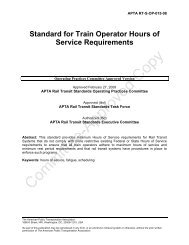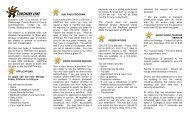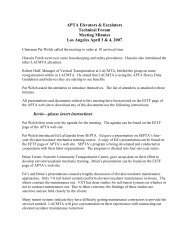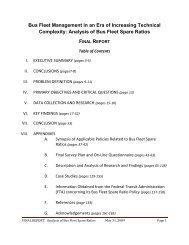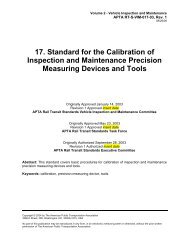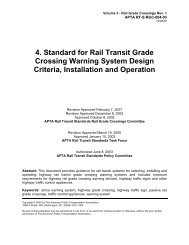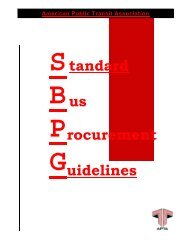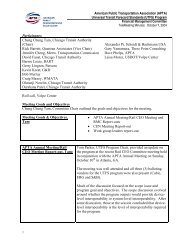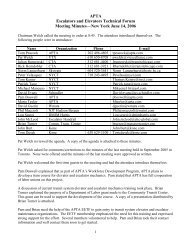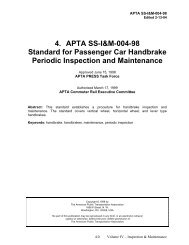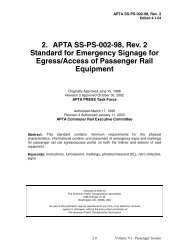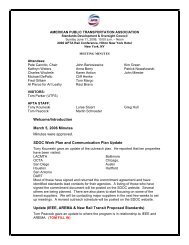Table of Contents - APTAStandards.com
Table of Contents - APTAStandards.com
Table of Contents - APTAStandards.com
Create successful ePaper yourself
Turn your PDF publications into a flip-book with our unique Google optimized e-Paper software.
e given careful consideration for adoption as the basis for development <strong>of</strong> an<br />
interchan ge specification for transit. This will require<br />
significant efforts to define<br />
<strong>com</strong>mon elements and aggregates <strong>of</strong> the transit industry specific data elements in XML.<br />
Secondly, it requires definition <strong>of</strong> the APTA proposed message types<br />
as XML schemas.<br />
XML is widely accepted, and replacing a variety<br />
<strong>of</strong> fixed and variable format messages<br />
in other industries. With the rapid emergence <strong>of</strong> fast and efficient<br />
XML parsers,<br />
interface s<strong>of</strong>tware development is minimized. XML parsers that create and breakdown<br />
XML messages and convert them to and from<br />
internal formats are widely available.<br />
Micros<strong>of</strong>t is s trongly supporting XML throughout their s<strong>of</strong>tware products, which<br />
encourages even wider familiarity and adoption <strong>of</strong> the standard.<br />
Tags theoretically add<br />
bulk to data transmission, however,<br />
this is be<strong>com</strong>ing<br />
less significant in practice with the<br />
advent <strong>of</strong> faster and cheaper <strong>com</strong>munication networks. Also, schemas are traditionally<br />
more <strong>com</strong>plicated than message layouts but are more powerful, describing<br />
the<br />
requirements, and enumerations <strong>of</strong> values in a consistent, and standard manner.<br />
Extensibility is critical when designing a message protocol. A consistent problem with<br />
fixed and vari able format messaging is that new needs are <strong>of</strong>ten difficult to<br />
ac<strong>com</strong>modate.<br />
XML is easier to extend to new device and message needs.<br />
4.3.3 Common Message Structure<br />
Basic OFX data consists <strong>of</strong> a declaration and an OFX data block. The standard XML<br />
declaration must <strong>com</strong>e first, which includes an option to specify the version <strong>of</strong> XML<br />
being used, and options to show such things as the encoding declaration and the<br />
standalone status <strong>of</strong> the document as illustrated in Exhibit 4.3-2.<br />
Exhibit 4.3-2 Processing Instructions<br />
<br />
The OFX declaration must <strong>com</strong>e next in the file with the following attributes as<br />
described in the following list and Exhibit 4.3-3.<br />
• OFXHEADER<br />
• VERSION<br />
• SECURITY<br />
• OLDFILEUID<br />
• NEWFILEUID<br />
Page 33



